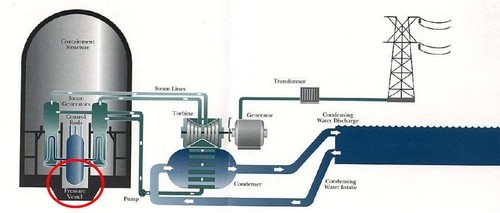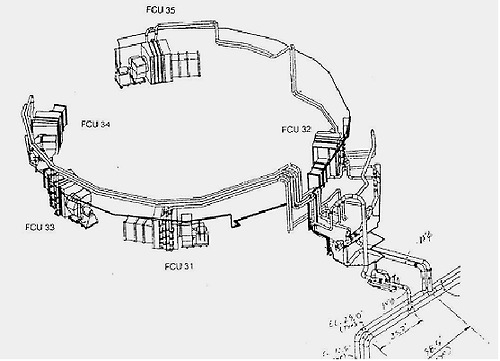Much has been said and written recently about water leaking out of nuclear plants (e.g., see this and this.) That’s certainly a problem worthy of discussion. The flip-side—water leaking into nuclear plants—has also caused problems. The Fission Stories series begins with an account of such a problem at Indian Point. Similar problems will be recounted in the following weeks.
Workers entered the containment building at Indian Point Unit 2 north of New York City on October 17, 1980, to repair a broken instrument. They discovered water on the containment floor. It wasn’t a damp spot or even a puddle, but nearly 100,000 gallons of water covering the containment floor. It filled the reactor cavity under the reactor vessel deep enough to submerge the lower nine feet of its metal surface.

The water came from numerous leaks in the containment fan cooling units. These coolers had a history of leaking. Indian Point Unit 2 has five large water-cooled fan units (FCU 31 to FCU 35 in the diagram) inside the containment building. Water drawn from the Hudson River flowed through pipes into the containment building and through the five fan cooling units. Fans circulated air from inside the containment building across the metal tubes in the fan cooling units. Heat from the containment air passed through the metal tube walls and was carried away by the service water. The warmer water exited the containment through pipes and was returned to the Hudson River.

The rising water was not discovered sooner because both of the indicating lights for high water level in the containment had broken. The moisture level indicators for the containment did not reveal the flood because they were designed to sense high humidity caused by leaking hot water or steam and were not sensitive to the lower moisture levels in the air from cold water leaks.
The rising water was not automatically pumped out of the reactor cavity because both transfer pumps were broken—one due to a blown fuse and the other due to binding of its float switch. The rising water was eventually detected when it submergeda nuclear instrument causing it to short out. The workers who found the flooded containment had entered it to repair this failed nuclear instrument.
One of the traps that factored into this event still plagues the nuclear industry. Tolerance of safety equipment failures based on reliance on backup safety equipment—without first ensuring the backups have not also failed—continues to happen. In this case, the containment fan cooler units had a long history of leaking. It was considered okay for these leaks to occur, since there was a pump installed inside the containment building to transfer out any water leaking into containment. It was considered okay for this pump to fail, since there was a second pump installed to transfer out the water. It was considered okay for both pumps to fail, since there was a level switch to alert operators to rising water level inside the containment. It was considered okay for that level switch to fail, since there was a second level switch installed to warn the operators about rising water level. Yet, as unlikely as it might seem, all of these systems failed.
There’s a saying that two wrongs don’t make a right. That saying should not be viewed as a challenge to figure out how many wrongs it does take to make a right.
Our Takeaway
What this incident shows is how a small problem ignored for a long time can grow to epidemic proportions. Workers knew that the service water system inside containment at Indian Point Unit 2 was leaking. But it was only a small leak from a non-emergency system. Over time, that neglected problem disabled instrumentation used to monitor the reactor power level and even posed a direct threat to the integrity of the reactor vessel itself. Have the lessons from this internal leakage problem at Indian Point Unit 2 been learned? Well, not at Indian Point Unit 2. Since 1993, nearly two million gallons of water have leaked into containment. Both the plant’s owner and the NRC are well aware of this recurring leakage, but neither seems willing to do anything about it. If looking the other way was an Olympic event, NRC would bring home the gold.
“Fission Stories” is a weekly feature by Dave Lochbaum. For more information on nuclear power safety, see the nuclear safety section of UCS’s website and our interactive map, the Nuclear Power Information Tracker.
